With the advent of home refrigerators, ice became present in our homes in winter and summer. Washing with ice tightens wrinkles and rejuvenates the skin. Two or three of his cubes will be very useful in a glass of dry martini and perfectly set off the taste of old Scotch whiskey. Having gathered your friends for a get-together, you can pleasantly surprise them by preparing light and aromatic cocktails. When arranging a picnic in nature in the summer, you can keep drinks cool for a long time by placing them in a special container filled with frozen cubes. Owners of cafes, bars, restaurants and grocery stores require tens and hundreds of kilograms of this unique product every day. And here one cannot do without special devices capable of producing it. The editorial staff of the site "bestx.htgetrid.com/en/" offers you an overview of the best icemakers for 2020, based on feedback from buyers and experts.
Content
A bit of history
As soon as a person appreciated the beneficial properties and capabilities of ice, he no longer parted with this gift of nature. Since ancient times, people have equipped cellars for storing meat and dairy products and fish, in which they placed frozen blocks of river and lake water, carved in winter on the nearest rivers. Even in summer, the temperature in them did not rise above minus five degrees Celsius.
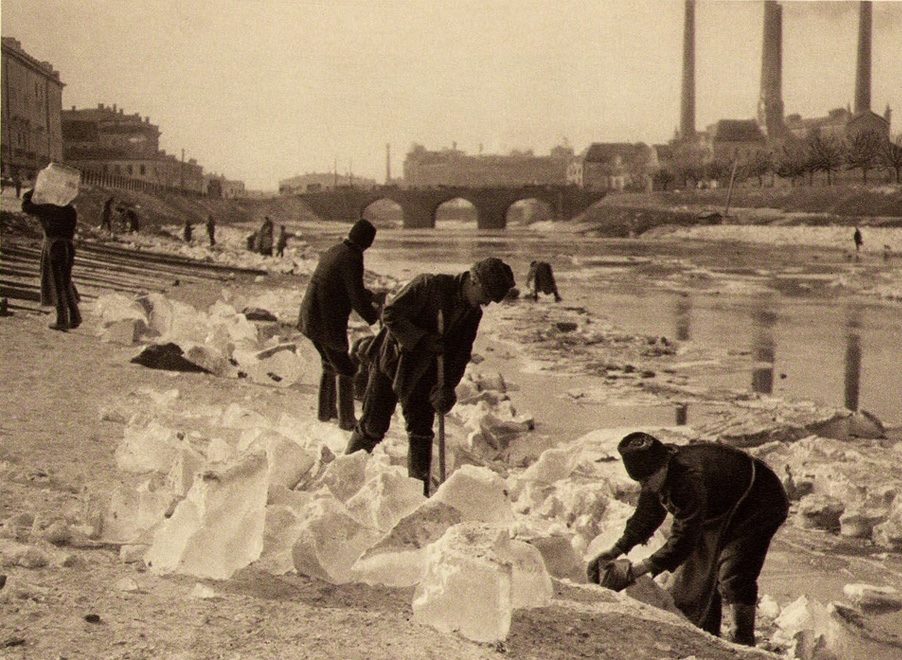 At the beginning of the 18th century, enterprising Americans set up a very lucrative business - the natural ice trade. Beginning in 1806, New England entrepreneur Frederick Tudor succeeded in distributing his wares across the southern states, England, Australia, India, China and South America by 1840. With the growth of cities in the eastern and midwestern United States, the demand for frozen water has grown exponentially. New York and Philadelphia consumed huge amounts of this product, especially during the hot summer months.
At the beginning of the 18th century, enterprising Americans set up a very lucrative business - the natural ice trade. Beginning in 1806, New England entrepreneur Frederick Tudor succeeded in distributing his wares across the southern states, England, Australia, India, China and South America by 1840. With the growth of cities in the eastern and midwestern United States, the demand for frozen water has grown exponentially. New York and Philadelphia consumed huge amounts of this product, especially during the hot summer months.
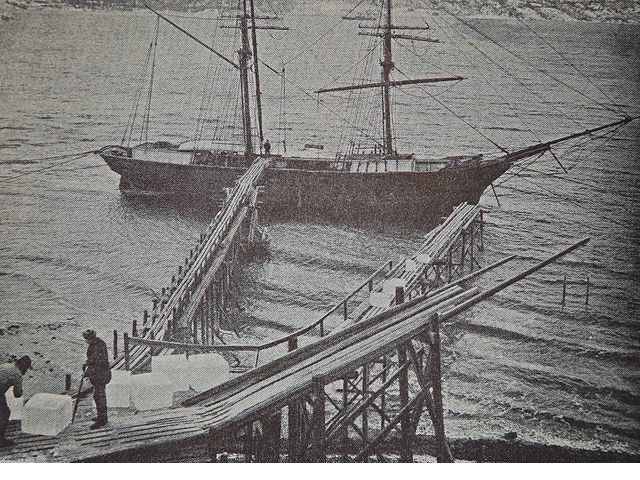
Interesting! The growing consumption of ice has been the impetus for the development of rail and truck refrigerators. This, in turn, led to the development of the meat industry, since there was no longer the need to drive herds on their own to the consumer. It became possible to slaughter livestock on the spot, butcher, pack and send it in wagons and refrigerated cars to consumers in the United States and overseas.
For the same reasons, the American vegetable and fruit industry, and the fisheries in Britain and the United States, were experiencing rapid growth during this time. The frozen water trade has boosted the world's largest economy!
Nowadays, like two centuries ago, ice is indispensable. True, now no one is sawing him on the river. Finding a sufficiently pure natural product in our time is almost unrealistic or very expensive.It is still used for storing perishable food, chilling drinks in bars and restaurants, and decorating windows with meat and fish products in large stores. The constantly growing needs are fully satisfied by the product of artificial freezing of drinking water. It is obtained in any quantity and of excellent quality using special refrigeration equipment.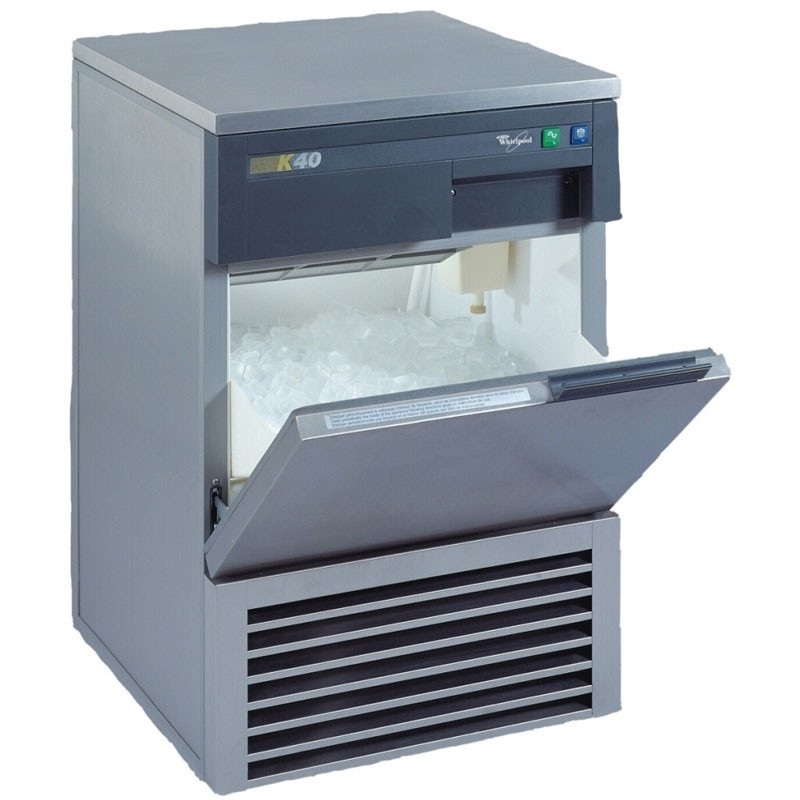
The first device for freezing water was created by John Gorrie, a physician based in Appalachicola, Florida. As a doctor, he knew that pathogenic microbes develop faster in warm and hot environments. To successfully cure his patients, the young physician needed to lower the temperature in the wards of a hospital located in one of the hottest states in North America. To do this, they had to buy and bring frozen slabs cut from the surface of lakes and rivers.
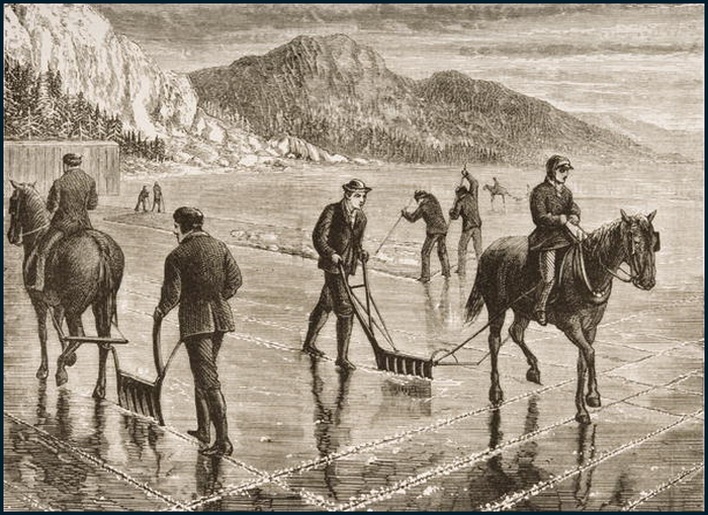 Place them in hospital rooms and manually "disperse" the cooled air around the room.
Place them in hospital rooms and manually "disperse" the cooled air around the room.
Gorrie was familiar with the writings of Oliver Evans and his partner Jacob Perkins, who received a patent for the invention of the refrigerator in 1834. The invention was based on the property of the gas to cool during expansion.
Gorri left medical practice and took up work on improving the refrigerator. He compressed the gas tenfold, then released it into a container in which a vessel with water was located. Ammonia was used as a refrigerant. The experience was a success. In 1850, Gorrie used his device to freeze water and obtain a patent for his invention.
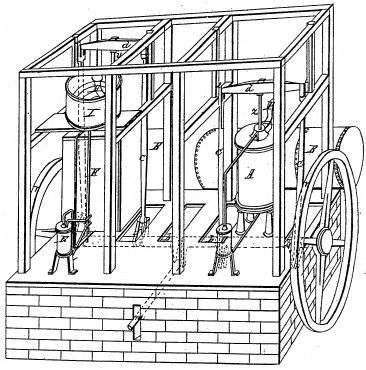 He failed to start industrial production of the much-needed device. Only at the end of the 19th century did the first industrial refrigerators appear. Humanity used household appliances for the first time only in the twenties of the XX century.
He failed to start industrial production of the much-needed device. Only at the end of the 19th century did the first industrial refrigerators appear. Humanity used household appliances for the first time only in the twenties of the XX century.
Interesting! It is possible that humanity would have used artificial ice already in the middle of the 19th century, if it had not been prevented by traders of natural goods. Not wanting to lose their profits, they tried in every possible way to "strangle" inventions dangerous to them. Only the unusually warm winter of 1889/1890, and even the pollution of rivers and lakes with industrial effluents, led to a breakthrough in the creation of devices for freezing water.
How an icemaker works
Freons are used as a working substance (refrigerant) in refrigeration equipment - mixtures of methane or ethane with fluorine or chlorine. In the USSR, and then in the Russian Federation, they were called freons. Features of freons lie in their ability to boil even with a slight decrease in pressure. Boiling is accompanied by the transformation of liquid into vapor, with the absorption of a huge amount of heat from the surrounding space (latent heat of vaporization). This creates artificial cold. But how to make freon boil? Very simple. You need to direct it into a thin tube, twisted into a spiral, which is called an evaporator. The freon pressure in the evaporator is reduced enough to start boiling.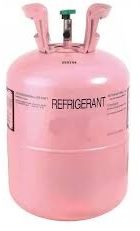
Interesting! Freons are transported in cylinders marked R ***, where *** is the digital designation of the number of fluorine, hydrogen and carbon atoms in the compound; the letter R stands for Refrigerant, i.e. cooler.
So, we sent the refrigerant to the evaporator, got a negative temperature on its surface. To continue the cycle, the hot gaseous freon must be returned to a liquid state and cooled. The compressor does this. It picks up the heated vaporous freon from the evaporator and drives it into the condenser, which is also a coil. Passing through this coil, hot freon gives off heat to the surrounding air and condenses (passes from a vapor state to a liquid). Then, the cooled saturated freon again enters the evaporator and the process is repeated.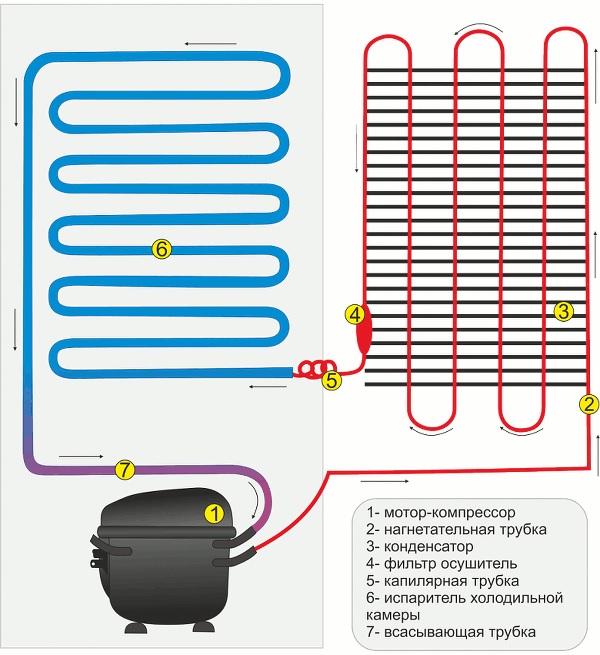 This is the general principle of operation of compressor refrigeration equipment.
This is the general principle of operation of compressor refrigeration equipment.
What are the ice makers
By the shape of the finished product
Water is supplied to the surface of the evaporator. It freezes and takes the form of an evaporator (cubes, columns, etc.). Then hot freon from the condenser is briefly fed to the evaporator.The finished cubes (or other forms) are slightly thawed, separated from the evaporator and dumped into the accumulator.
Cubes
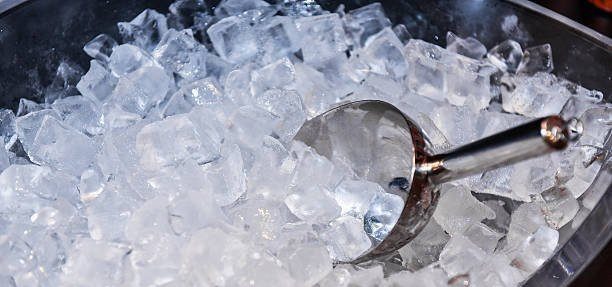
This form is used to cool drinks. Recently, the cubes are giving way to their "fingers". This is the name of ice in the form of a hollow thimble. Its contact area with the drink is larger than that of the cube, the cooling process is faster.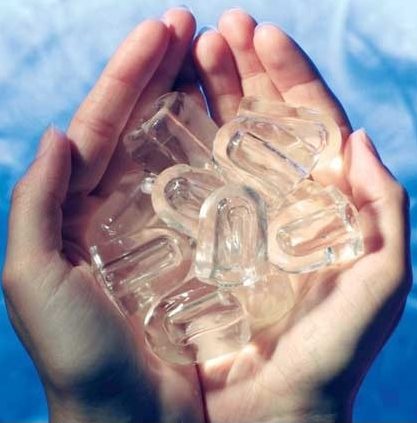 However, cubes are in no hurry to give up their positions and do not lose their popularity among visitors to cafes and bars. In accordance with the shape of the evaporator, the devices can dispense product in the form of cones, cylinders, sickle-shaped and hexagonal ones. The principle of obtaining the finished product is the same: freezing on the evaporator, thawing, collecting in a container.
However, cubes are in no hurry to give up their positions and do not lose their popularity among visitors to cafes and bars. In accordance with the shape of the evaporator, the devices can dispense product in the form of cones, cylinders, sickle-shaped and hexagonal ones. The principle of obtaining the finished product is the same: freezing on the evaporator, thawing, collecting in a container.
Plates or scales
Cubes, cylinders and other artificially frozen geometric shapes are not suitable for store counters and stores of meat and fish products. The area of contact of products with them is extremely small, cooling is not effective, money is wasted. Special devices produce frozen granules and plates (or scales) for these purposes.
To obtain flake ice, a drum type evaporator is used. The scheme is simple.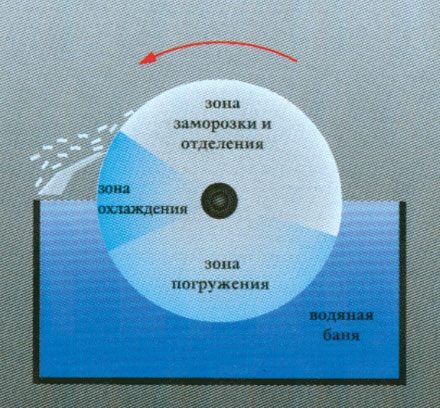 The evaporator drum rotates in a bath of water and is covered with ice. Parallel to the drum, a knife is fixed on the generator body. The frozen mass of water builds up on the evaporator surface up to two mm thick and is cut off with a fixed knife. The scaly form has the lowest temperature (from minus 6 to minus 12 degrees). Ideal for storing fish and seafood, meat and vegetable products.
The evaporator drum rotates in a bath of water and is covered with ice. Parallel to the drum, a knife is fixed on the generator body. The frozen mass of water builds up on the evaporator surface up to two mm thick and is cut off with a fixed knife. The scaly form has the lowest temperature (from minus 6 to minus 12 degrees). Ideal for storing fish and seafood, meat and vegetable products. 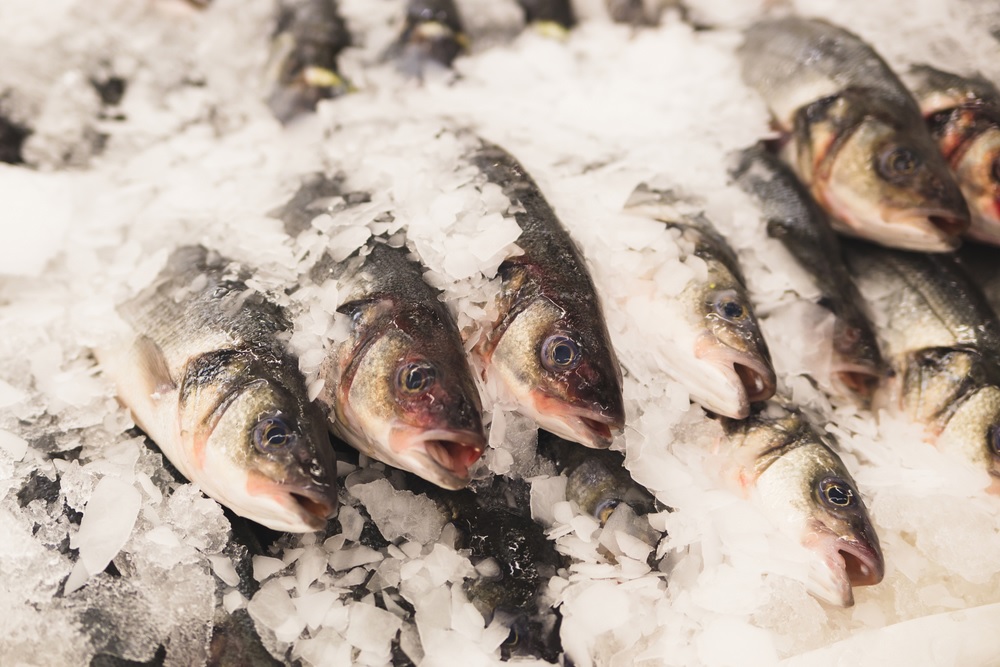 It is widely used on ships of the fishing fleet, meat and fish processing plants, in confectionery shops. Looks great in the window dressing of grocery stores.
It is widely used on ships of the fishing fleet, meat and fish processing plants, in confectionery shops. Looks great in the window dressing of grocery stores.
Granules
The granulated mass is produced in a similar device. The same rotating drum - the evaporator is doused with water. A layer of frozen water is cut off from the surface of the drum by an auger or a milling cutter, crushed and frozen again.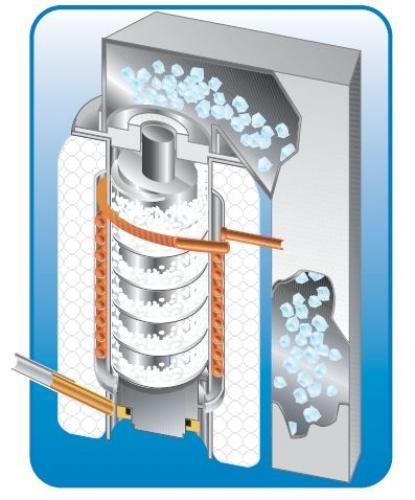 Small size of granules, from 5 to 10 mm, makes it possible to use them in cafes and bars for cooling drinks. Perfect for a store, when decorating shop windows and counters with meat and fish products. It is widely used in restaurants to cool champagne, salads, seafood.
Small size of granules, from 5 to 10 mm, makes it possible to use them in cafes and bars for cooling drinks. Perfect for a store, when decorating shop windows and counters with meat and fish products. It is widely used in restaurants to cool champagne, salads, seafood.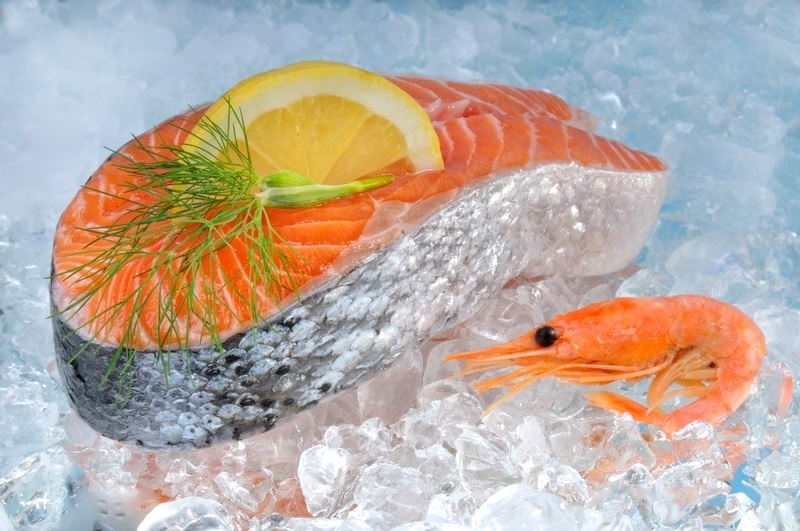 Unlike plates, granules do not have sharp edges, contact more gently with the surface of refrigerated products, do not damage the hands of personnel.
Unlike plates, granules do not have sharp edges, contact more gently with the surface of refrigerated products, do not damage the hands of personnel.
Generator selection criteria
By performance
This characteristic of the equipment is determined by the amount of product it produces per unit of time. When evaluating it, they usually mean the number of kilograms of products produced during the day. This characteristic can fluctuate depending on the room temperature and the temperature of the water supplied to the evaporators. The ideal conditions are considered to be an air temperature of 21 ° C and a water temperature of 15 ° C. When buying a device, it should be borne in mind that fluctuations in these temperatures can significantly affect the nameplate performance of the device.
By water supply method
Devices of small capacity are equipped with a container into which water is poured before starting the process. If necessary, water is added to the container manually. Such generators are called autonomous or flooded. They do not produce more than 10 - 15 kg of product per day, are inexpensive and are ideal for a bar, small cafe or home.
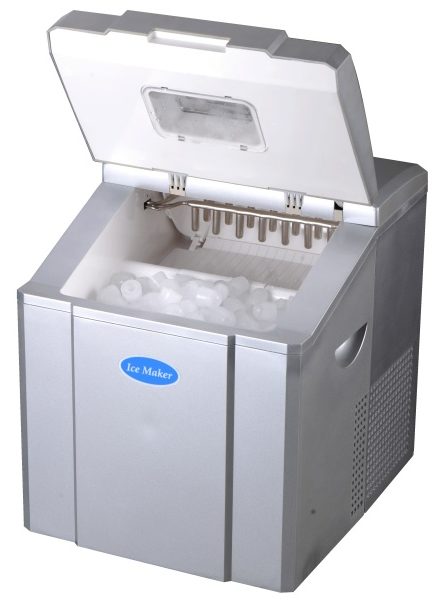
In addition to flooded generators, there are models with water supply from the water supply network, through pipelines and flexible hoses. Such generators are called flow generators. Drinking water is constantly supplied to the device. When the device is turned on, the inlet valve at the inlet opens. At the end of the cycle, the valve closes. Excess moisture is discharged into the drain. Install on the supply line water softeners and aquafilters, shut-off and control valves (valve or valve). Stationary devices produce from 20 kilograms to a ton or more of artificially frozen water per day.
By the method of equipment cooling
Cooling and the transition of the refrigerant from gaseous to liquid state occurs, as we have already established, in the condenser of the unit. You can cool it in different ways. In household refrigerators, for example, the condenser is cooled naturally by transferring heat from the surface of the condenser to the ambient air. As the performance of the equipment increases, its thermal characteristics will increase so much that free cooling will not be enough. In such cases, forced cooling, water and air, is used.
Water cooling
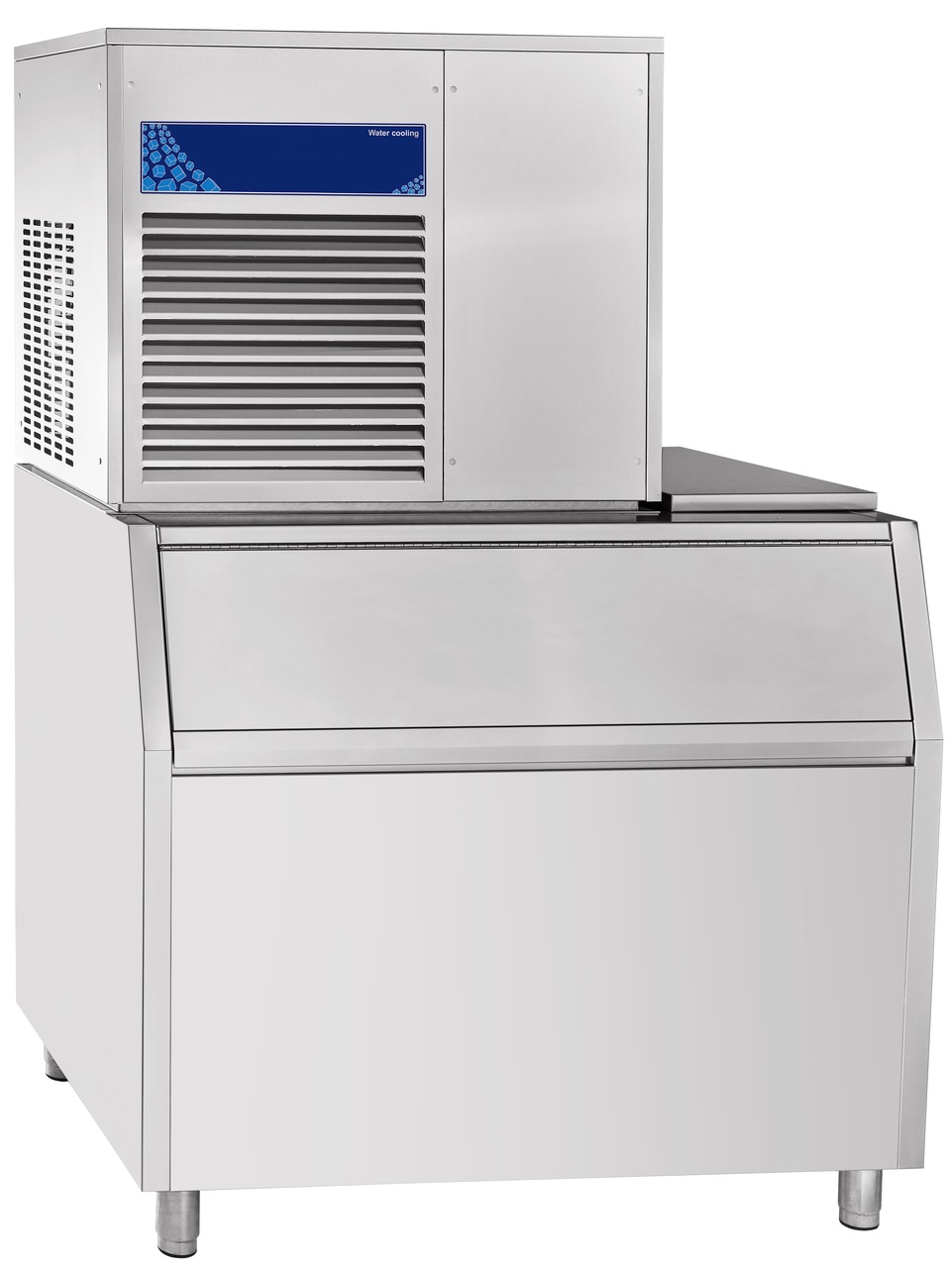
The water-cooled generator works stably, consumes less electricity and does not heat the premises. But the water consumption is large enough and you have to pay for water. water cooling is justified only in organizations with stable profits and high consumption of artificial ice.
Natural air cooling
Natural air cooling of the air conditioner requires a free space between the unit and the walls of the room to ensure sufficient air exchange. And the greater the performance and, accordingly, the heat release from the air conditioner, the more this free space should be. Do not place powerful generators that emit a significant amount of heat in small and poorly ventilated rooms.
Forced air cooling
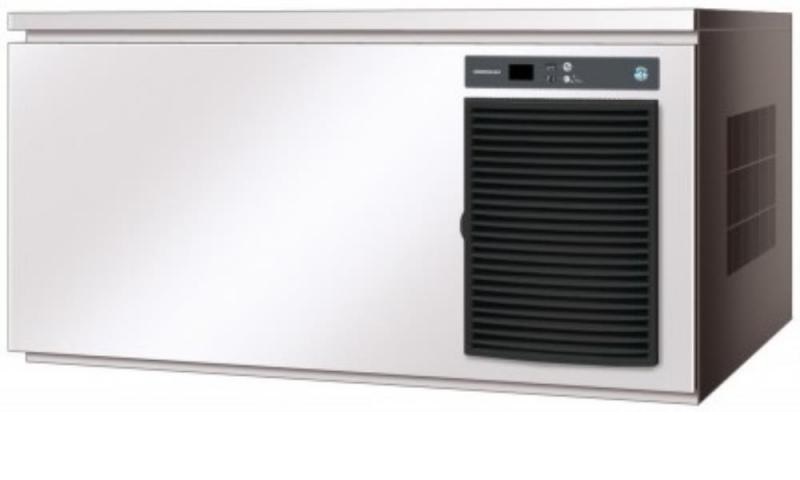
For generators with forced air cooling, the condenser is blown by a fan. The solution is energy-intensive, since in addition to the compressor motor, the blower fan is also powered by electricity. In addition, this type of generator is characterized by an increased noise level. This solution is suitable for high-power industrial devices. In this case, the consumption of electricity is compensated by the profit from the amount of products produced. In addition, noise from a fan in a workshop or large storage room will not disturb anyone.
Remote equipment
A good option for devices with forced airflow is external equipment. The air conditioner, compressor and fan are located outdoors (outdoors), does not create noise and does not take up much space in the room, does not affect its thermal balance.
What to look for
Water purification
Water from the water supply network is replete with harmful impurities and suspended particles. Untreated water can harm consumer health, chilled delicacies, and equipment failure. Individuals and owners of bars and cafes should know: if the master of the service center establishes poor-quality water as the cause of the breakdown of the unit (and it will not be difficult to determine this), there can be no question of warranty repair. The benefits of having a water filter can hardly be overestimated:
- Water purification from impurities that impair the taste of the product;
- Prevention of the accumulation of suspended particles in the apparatus, reducing its performance;
- Protect compressor and seals from damage caused by accumulated suspended solids, preventing major malfunctions, repairs or replacement costs.
Hard water softener
Hard water can render equipment unusable ahead of time and severely reduce ice quality. To avoid problems, it is necessary to analyze the water for the presence of calcium and magnesium salts. If this figure exceeds 3.99 mg-eq / l, it is better to take care of its softening. There are more than enough devices for this on sale: filters - jugs, ion-exchange, reagent-free and electromagnetic installations.
Optional equipment
Bunker for storage of finished products
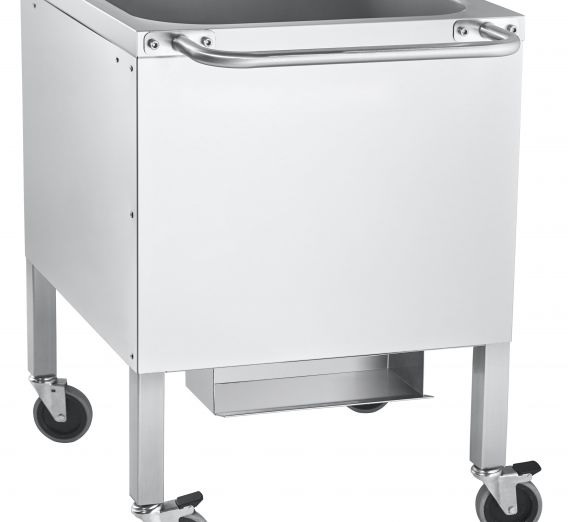
This is the device where ice is stored. It will not be superfluous at all in bars and cafes. All generators are equipped with small storage bins.Larger hopper can be purchased separately. The stock stored in the drive will allow you to serve all comers without delay, even if the generator does not have time to prepare the next portion of cubes in time. The client doesn't have to wait!
Scoop
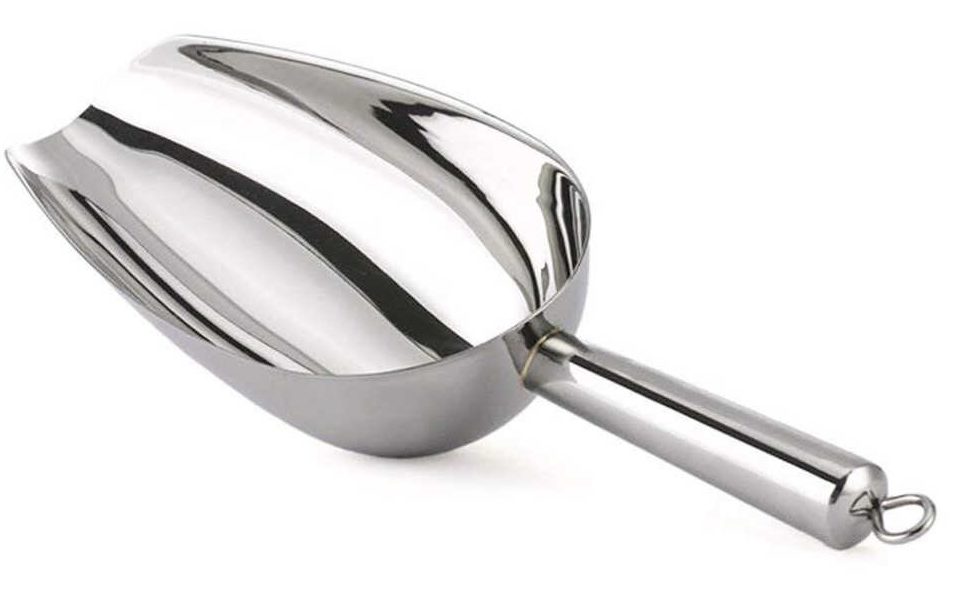
It is inconvenient to type cubes or fingers with your hands (there is no need to talk about aesthetics). The presence of this tool will show the client that crystal clear ice is being collected with a clean tool. In addition, if you choose a design option that is pleasing to the eye, both the user and the client will benefit from this. Ladles are included in the delivery. But they quickly break or disappear somewhere. The cost of the new design option ranges from $ 5 to $ 10.
Top manufacturers
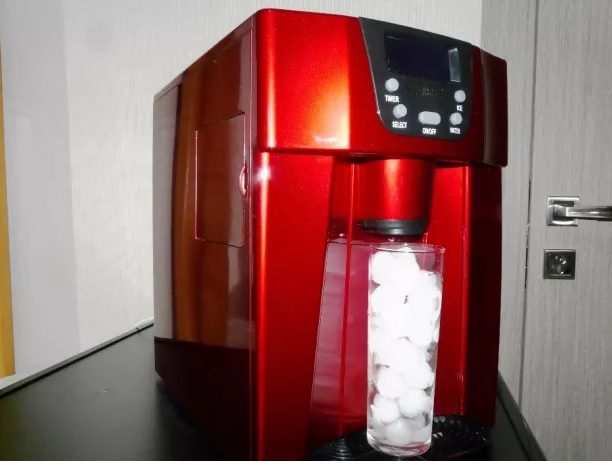
When buying any equipment, questions always arise: "How much does it cost?" and "Which company is the best device to buy?" The popularity of models directly depends on the quality of their assembly, so you need to choose a device from well-known manufacturers, whose reputation in the market for quality goods is quite high.
First, you need to calculate the performance of the device so that there are no problems with a shortage or excess of the product. When choosing the right model, you should consult your wallet. Powerful units from global brands cost a lot of money. Italian professional apparatus Brema Muster Split, with a capacity of up to 400 kg / day of flake or granulated ice, cost an average of 25,000 to several hundred thousand rubles.
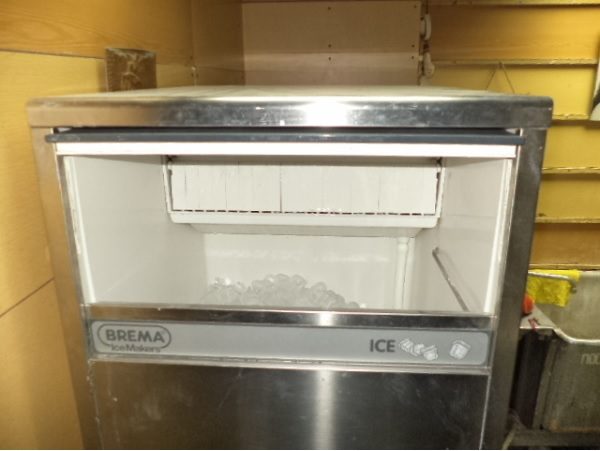 Quite budget devices are produced by the Chinese companies Edit, Gastrorag and others. Their desktop stand-alone generators with a capacity of 10-15 kg / day cost an average of 7,000 to 12,000 rubles. In addition to the named companies, the popular models of Italian companies Scotsman, NTF, Apach, Convito, Ise Matic, German brands Wessamat, Caso, Clatronic, Profi Cook, American Manitowoc and Japanese Hoshizaki deserve attention. The price range is wide enough, depending on the functionality and performance.
Quite budget devices are produced by the Chinese companies Edit, Gastrorag and others. Their desktop stand-alone generators with a capacity of 10-15 kg / day cost an average of 7,000 to 12,000 rubles. In addition to the named companies, the popular models of Italian companies Scotsman, NTF, Apach, Convito, Ise Matic, German brands Wessamat, Caso, Clatronic, Profi Cook, American Manitowoc and Japanese Hoshizaki deserve attention. The price range is wide enough, depending on the functionality and performance.
Built-in generators
Many do not understand what an icemaker is for and believe that it is possible to do without it. Ice cube trays are included with any kitchen refrigerator, and that's enough.
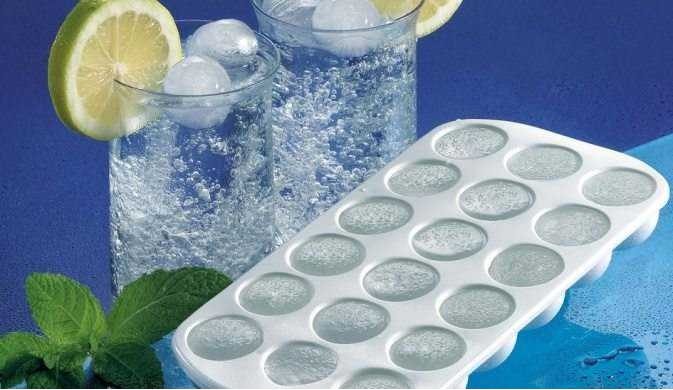 However, everyone knows how difficult it is to remove cubes from cursed molds. Often, with such attempts, the cubes completely end up on the floor.
However, everyone knows how difficult it is to remove cubes from cursed molds. Often, with such attempts, the cubes completely end up on the floor.
Try another option. Kitchen equipment becomes obsolete over time and requires replacement. New modern energy efficient models with various useful functions appear. When upgrading your refrigerator, change it to a machine with a built-in ice maker. There are many decent economical models on the market from the best European and Asian manufacturers. A small device built into the refrigerator door will cook a dozen cubes or fingers of an ideal shape within a few minutes.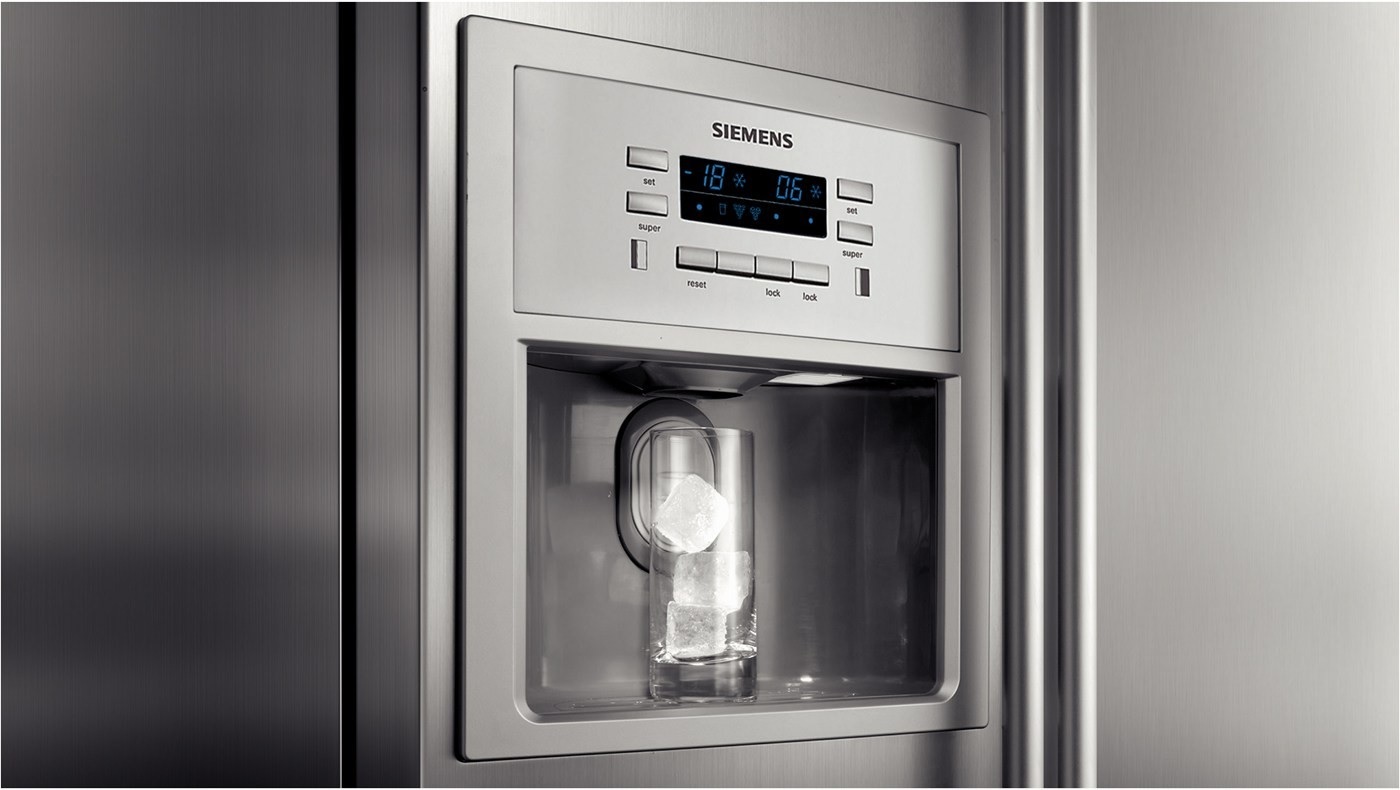 It remains to take them with a convenient scoop and lower them into glasses with a drink. Buying such a device is another small step towards improving the quality of life, quite affordable for everyone.
It remains to take them with a convenient scoop and lower them into glasses with a drink. Buying such a device is another small step towards improving the quality of life, quite affordable for everyone.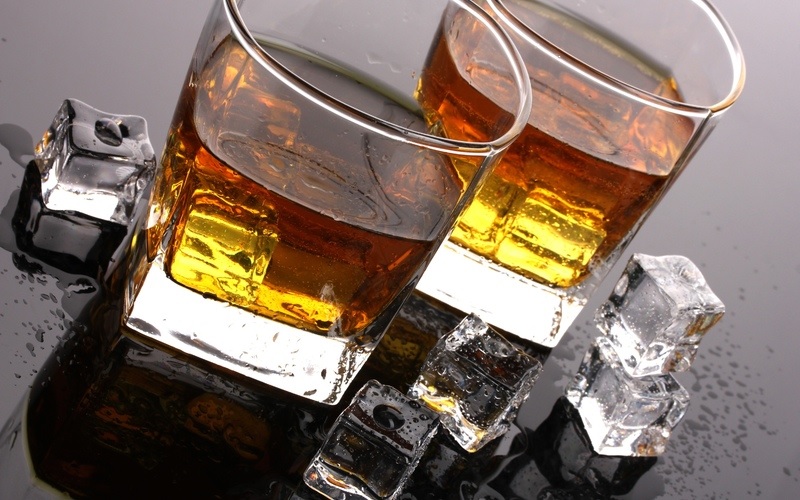
Before deciding which generator to buy, follow these steps:
- make a simple calculation of the required performance of your generator;
- decide on its dimensions (length * width * height), think over how to install it away from heating devices, with the necessary gaps near the walls for normal equipment cooling;
- think about what type of ice is more suitable for you;
- orient yourself on the price to get the desired effect and not overpay;
- determine for yourself what color your equipment should have in order for it to organically fit into the interior;
- Hear tips and advice from experienced users on how to choose the best model based on your input data;
- carefully read the description of the model and the instruction manual, find out everything that remained incomprehensible to the seller;
- be sure to establish the presence of a service center from the manufacturer of the model you have chosen, since its maintainability may not allow you to perform the simplest repairs yourself.
After a short acquaintance with the selection criteria, we suggest that you familiarize yourself with the rating of high-quality ice makers, compiled according to the opinions of buyers and experts.
Gastrorag DB - 02
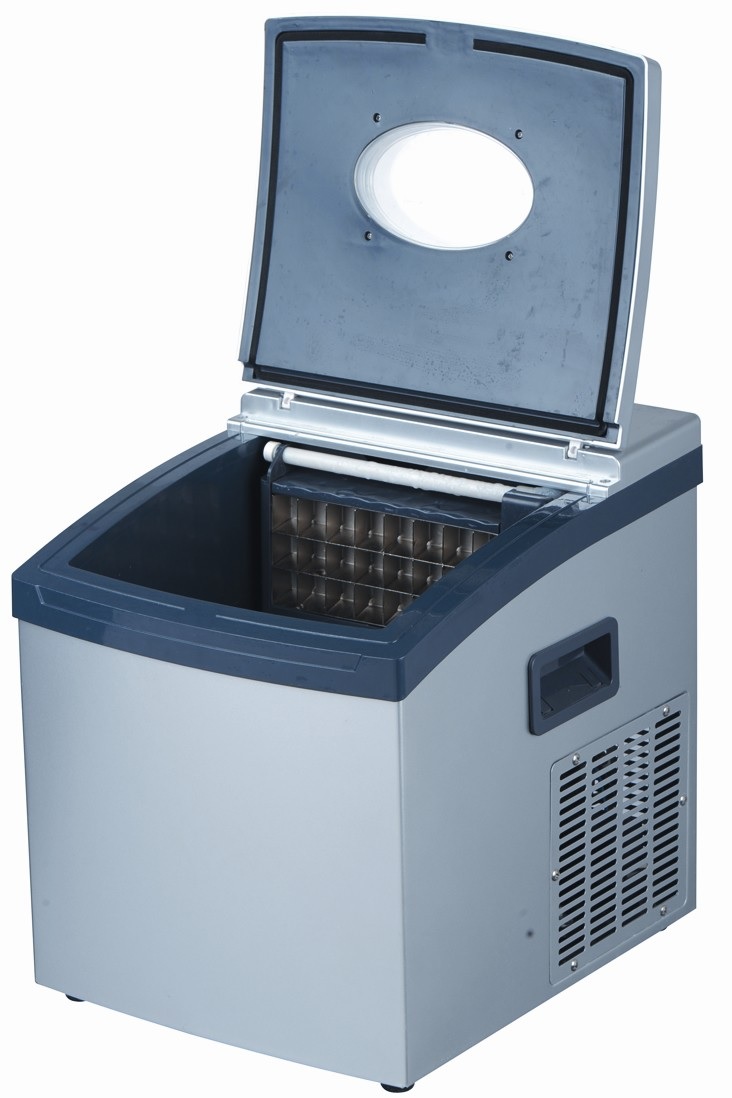
The tenth line of the rating is given by the buyers to the Chinese unit Gastrorag DB - 02. This is a compact table top unit, suitable for personal use and equipment of mini cafes and bars. Produces 15 kg of frozen cubes per day. The cycle time will not exceed 10 minutes. The lid with a viewing window and carrying handles indicate that the developers have taken care of the convenience of using their device. The average price of the generator is quite affordable and amounts to 10,076 rubles.
Advantages:
- quality ice cubes in two sizes;
- ease of carrying;
- the presence of a viewing window;
- affordable price.
Disadvantages:
- small size of the water tank (1.7 l) and the finished product hopper (1 kg).
Caso IseMaster Ecostyle
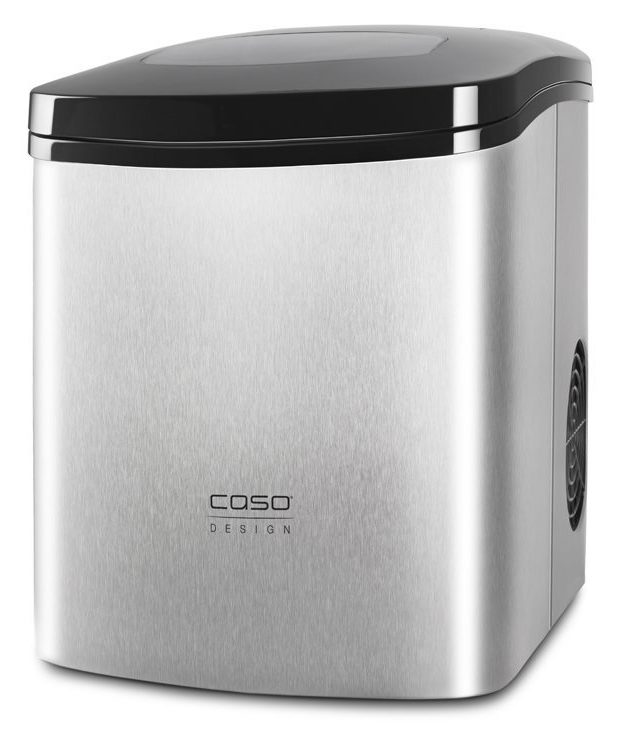
The ninth in our ranking is the German unit. Manufacturer - Caso IseMaster Ecostyle. A compact desktop stand-alone device weighing 13 kg, produces 12 kg per day. icy fingers. The body of the machine made of stainless steel and high-quality bottled water for refueling guarantee long-term trouble-free operation and excellent ice quality. The device is equipped with a hopper for storing the finished product (0.7 kg). For this device you will have to pay 19,990 rubles. This is its average price.
Advantages:
- the presence of indicators of the end of the cycle and the absence of liquid;
- short cycle time (from 6 to 13 minutes, depending on operating conditions);
- two sizes of fingers.
Disadvantages:
- small bin for storing the finished product.
Profi cook PC - EWB 1079
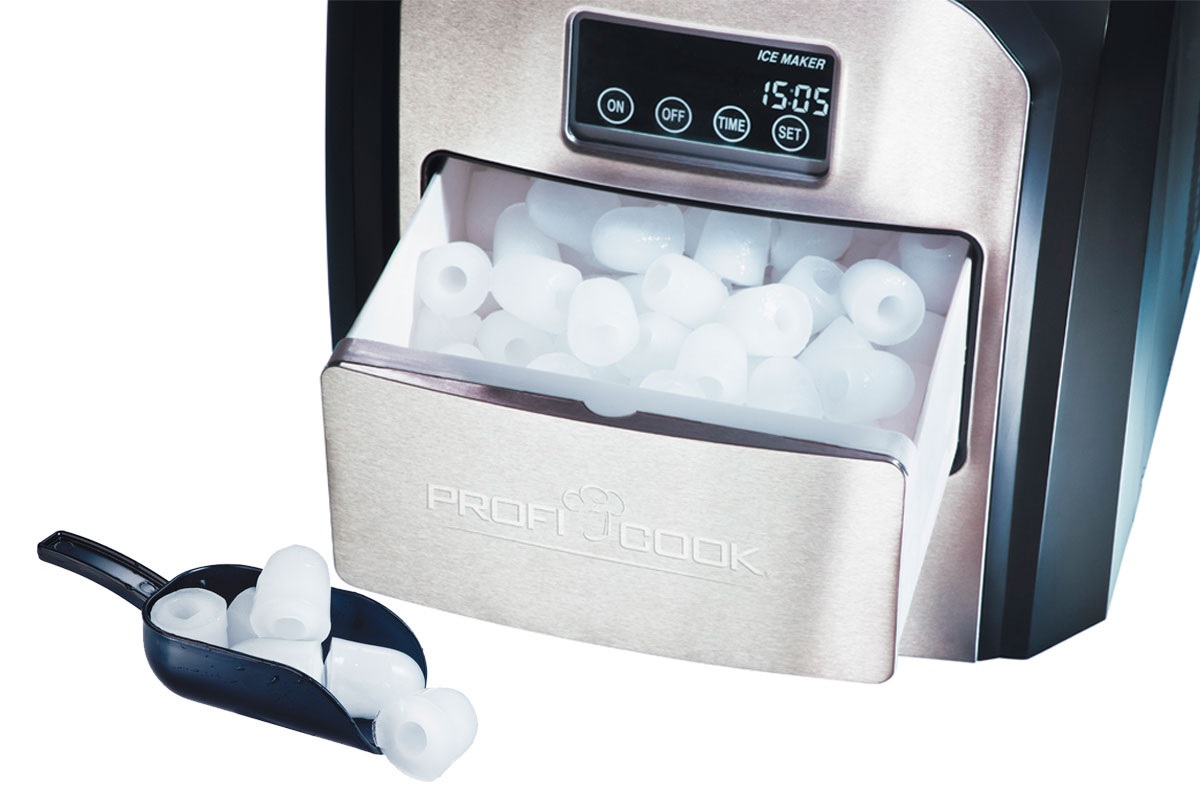
The eighth line of the rating was taken by another device from the German manufacturer Profi cook PC - EWB 1079. It is also very compact and light (weight only 10 kg), tabletop jellied generator with a fairly high performance, freezing up to 25 kg / day of ice fingers. Compared to the previous sample, with the same reservoir capacity of 1.7 liters, the generator is equipped with a more capacious (1 kg) storage hopper. The average price of the device is 22,999 rubles.
Advantages:
- the cycle time does not exceed 10 minutes;
- compact size;
- high performance;
- indicators of the end of the cycle and the level of liquid in the tank.
Disadvantages:
- high price.
Clatronic EWB 3526
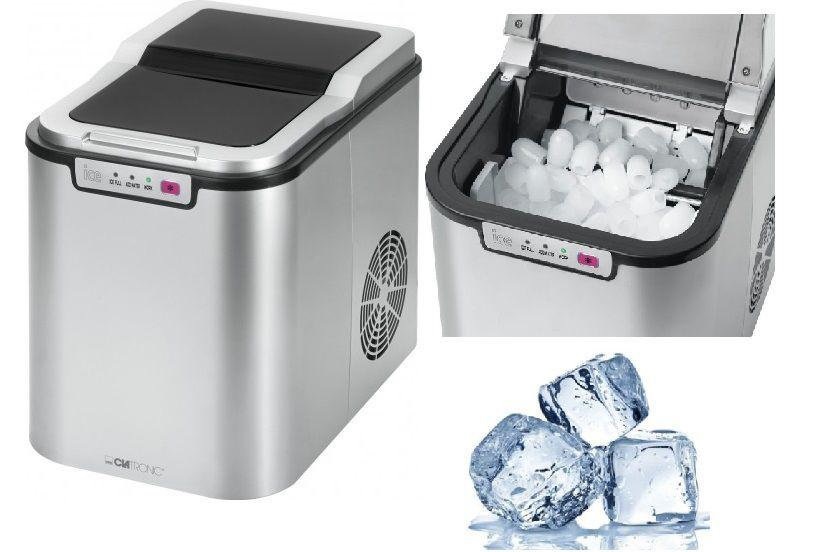
The seventh place is occupied by the device of the famous German brand (Chinese production) Clatronic EWB 3526. Just like the two previous German devices, there is a compact desktop jellied cube generator with a capacity of 25 kg / day. It differs from its "fellow countrymen" by an enlarged reservoir, with a capacity of 2.2 liters. Perfect for home, bar and cafe. The generator design may seem too simple to some users, but this is a matter of taste. The average cost is 15895 rubles.
Advantages:
- volumetric tank (2.2 l.);
- fast freezing cycle (no more than 10 minutes);
- indicators of the end of the cycle, switching on, water control.
Disadvantages:
- not the most stylish design.
Gastrorag IM - 50
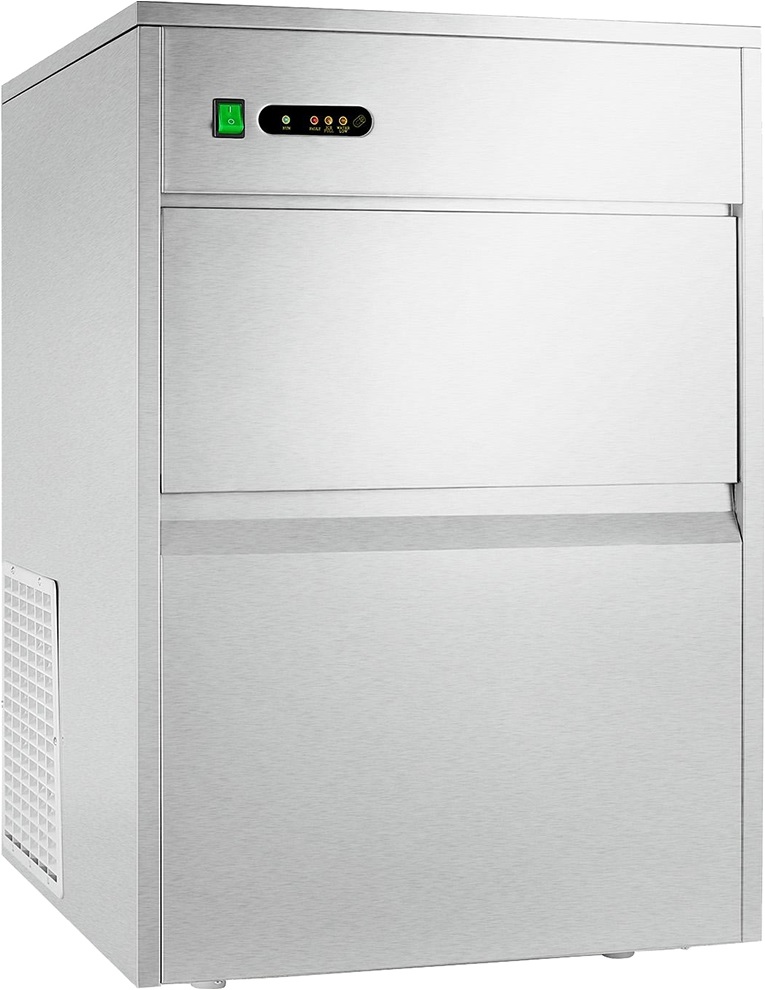
The sixth place in our review is taken by the Gastrorag IM - 50, a Chinese autonomous device for making ice fingers. The device is of medium size. Case material - stainless steel. The weight of the structure is 32 kg, so it is better to place it on the floor. The condenser is cooled by air, which means that it must be installed with a gap from walls and other equipment and away from heaters and heating. Water supply is provided by flexible hoses from the water supply network. The generator has a high productivity - 50 kg / day. This is enough to provide ice for a small bar or cafe. Its average price is equal to 33,553 rubles.
Advantages:
- good performance;
- the presence of a storage hopper (7 kg);
- automatic control of filling the bunker;
- water availability control.
Disadvantages:
- lack of a filter and a device for water softening.
NTF SL 50 A
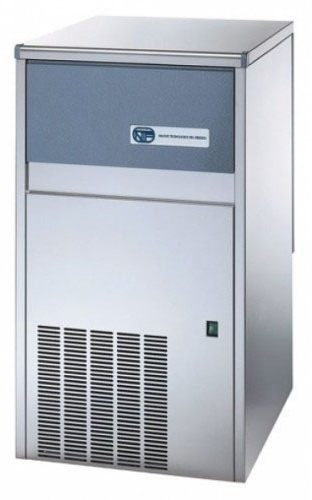
The fifth place in the ranking went to the representative of the famous Italian brand NTF. The device produces up to 28 kg per day. frozen water in the form of gourmet (cones), at an outside temperature of up to 21 degrees. C and water temperature no more than 10 degrees. C. Sufficiently large dimensions and solid weight - 39 kg do not allow installing it on a table. In addition, the device requires a water connection. The diameter of the water connection is 3/4 "(20 mm). The drainage diameter is one inch (25 mm). There is a built-in water filter that can be removed for cleaning. The generator performs well in bars, hotels and cafes. It can operate at ambient temperatures up to +40 degrees. S. (with reduced performance). The average price of the device is 62350 rubles.
Advantages:
- electromechanical control;
- sliding insulated door;
- capacious storage hopper (6 kg of ice).
Disadvantages:
- high price.
Apach ACB 3010A
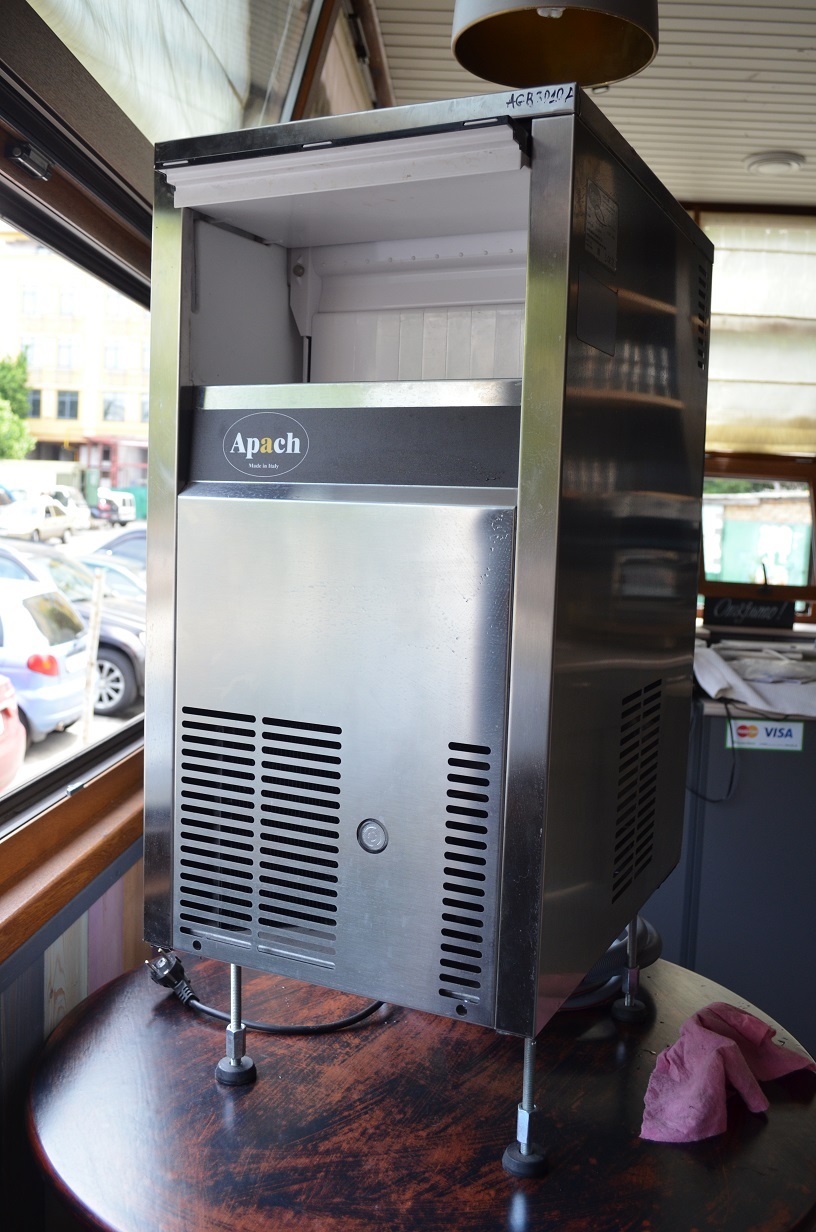
The fourth place went to the Italian Apach ACB 3010A unit. This is a floor-standing flow-through (connected to the water supply network) apparatus, producing up to 30 kg per day. cold ice fingers. The built-in storage hopper holds up to 10 kg of finished products. He is not afraid of hard water, there is a device for softening it. The Italian assembly makes it a highly reliable device capable of operating in high temperature conditions. Electronic controls with self-diagnosis function make it easy to operate. The purchase will cost the owner 61,160 rubles.
Advantages:
- great productivity;
- capacious storage hopper;
- electronic control and diagnostic system;
- built-in water softener.
Disadvantages:
- consumes a lot of electricity, the power of 480 W is quite large.
Hoshizaki IM - 45CNE
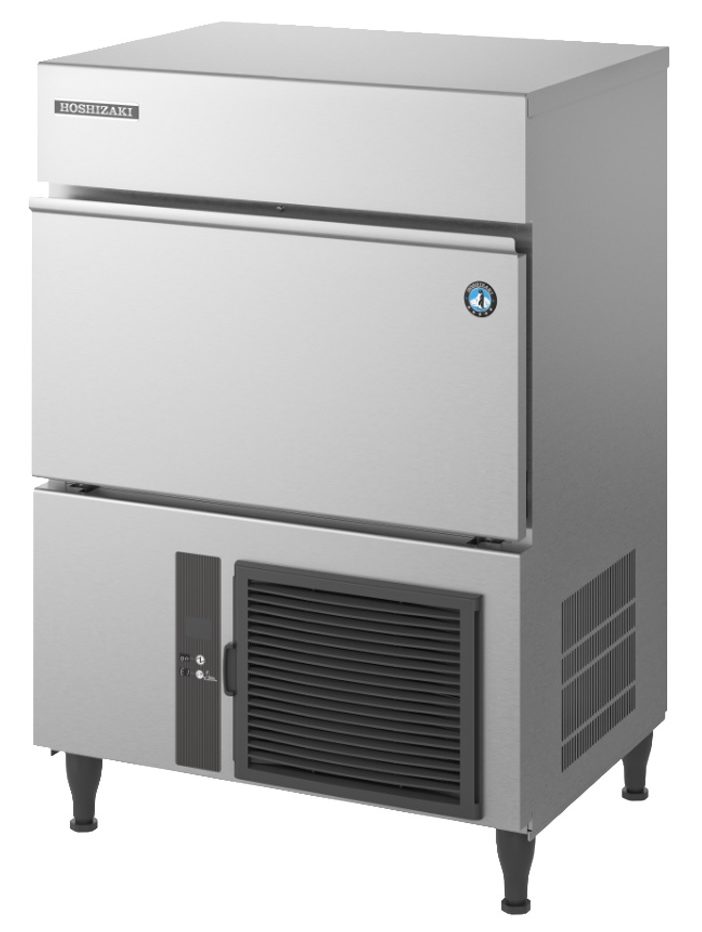
The best customer reviews were received by the floor-standing apparatus of the Japanese firm Hoshizaki IM - 45CNE, which occupies the third line in the rating. This is a floor-standing cube generator capable of producing 44 kilograms of cubes per day. The device is flow-through, connected to the water supply network, with a bunker with a capacity of 15 kg. cubes, dimensions 28x28x32 mm. Power consumption 280 watts. makes it more energy efficient than the previous model. Electronic control type. The device independently detects deviations from operating parameters and turns off in a timely manner, preventing breakdowns. With the return of the parameters to normal, switching on occurs automatically. An audible signal notifies the owner of a problem. The cost of the device corresponds to its performance, reliability and expanded functionality. It fluctuates around 105,400 rubles.
Advantages:
- high build quality;
- reliability and reliability;
- availability of replaceable cleanable water filters;
- electronic control and self-diagnostics.
Disadvantages:
- not found.
Manitowoc Ice SM - 50 A
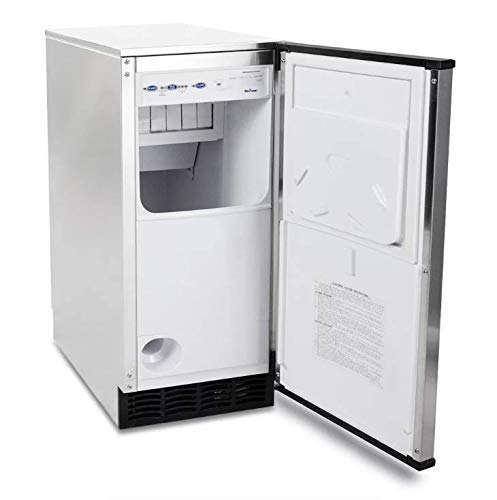
The second place in our review is given to the model of the American company Manitowoc Ice SM - 50 A. This is a device for professional use in cafes, bars and restaurants. Floor standing, flowing, produces up to 24 kilograms of granules per day, which are equally successfully used for making cocktails, cooling salads and displaying meat and fish products on the shelves of grocery supermarkets. The storage hopper holds up to 15 kg of finished granules. The automatic control has a delayed start function, thanks to which an experienced operator can program the device to turn on shortly before the end of the stock of finished granular mass. LED lighting inside the device allows you to monitor the process. The water purification system guarantees the production of a quality product.These excellent qualities will cost the buyer 120,000 rubles.
Advantages:
- energy efficiency;
- built-in water purification system;
- filter change indicator.
Disadvantages:
- high price.
Scotsman BF 80 AC
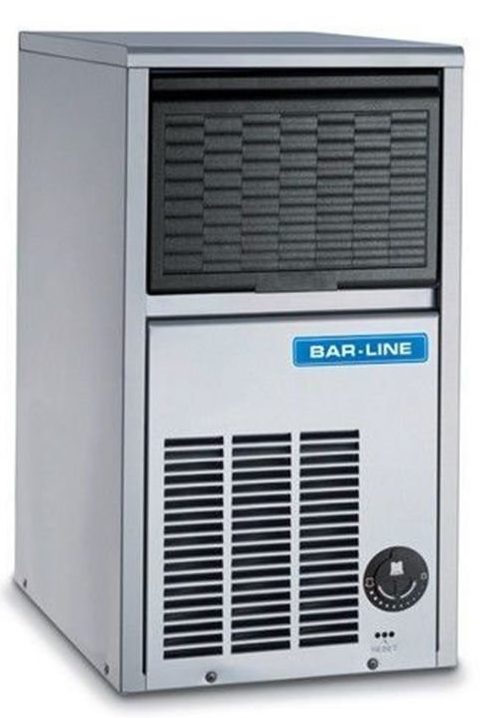
The first place in the rating, according to customer reviews and expert opinion, is occupied by a model from the Italian brand Scotsman BF 80 AC. Professional floor-standing flow-through equipment for the production of up to 71 kg of granular mass (frappe). Built-in water filtration and antibacterial housing guarantee high taste of the product. The storage hopper holds 15 liters of finished granules. The firm guarantees trouble-free operation for two years. Electronic control and self-diagnostics add to the many positive qualities of this modern and reliable ice maker. This pleasure is worth 150,620 rubles
Advantages:
- high performance;
- reliability and high-quality assembly;
- built-in water purification;
- electronic control and diagnostics.
Disadvantages:
- not found.
| Device name | Development / production | Main characteristics | average price |
|---|---|---|---|
| Gastrorag DB - 02 | China | Type: ice maker; Dimensions: 305x350x327 mm; weight - 13 kg. with pack .; ice - cubes; desktop, stand-alone, filler; produces. - 15 kg / day; bunker - 1.0 kg. Power 150 watts. | 10076 |
| Caso IseMaster Ecostyle | Germany | Type: ice maker; Dimensions: 243x350x340 mm; type of ice - finger; desktop, stand-alone; stainless steel body steel produces. - 12 kg / day; reservoir - 1.7 l; ice storage bin - 0.7 kg. Power 150 - W. | 19990 |
| Profi cook PC - EWB 1079 | Germany | Type: icemaker; Dimensions: 280x390x360 mm; weight - 10 kg; ice - finger; tabletop, stand-alone, filler; produces. - 25 kg / day; reservoir - 1.7 l; ice storage bin - 1.0 kg. Power 150 watts. | 22999 |
| Clatronic EWB 3526 | Germany / China | Type: icemaker; Dimensions: 245х330х370 mm; weight - 11.5 kg. with pack .; ice - cubes; desktop, stand-alone, filler; produces. - 25 kg / day; reservoir - 2.2 l; | 15895 |
| Gastrorag IM - 50 B | China | Type: icemaker for bar; Dimensions: 395x542x682 mm; weight - 32 kg; ice - finger; water connection - yes, running; produces. - 50 kg / day; ice storage bin - 7.0 kg; automatic control of filling the bunker. Power 150 watts. | 33553 |
| NTF SL 50 A | Italy | Type: ice maker; Dimensions: 387x kg. with pack .; ice - cubes; desktop, stand-alone, filler; produces. - 12 kg / day; reservoir - 2.2 l; bunker - 0.8 kg. Power 290 W | 62352 |
| Apach ACB 3010A | Italy | Type: ice maker; Dimensions: 395x495x690 mm; weight - 36 kg. with pack .; ice - cubes; floor; durable, water connection required; produces. - 30 kg / day; storage hopper - 10 kg; built-in water softener; Power 450 W. | 61159 |
| Hoshizaki IM - 45CNE | Japan | Type: ice maker; Dimensions: 633x511x690 mm; weight - 45 kg. ice - a large cube 28x28x32 mm; floor; flowing, water connection required; produces. - 44 kg / day; storage hopper - 15 kg. Power 280 W. | 105362 |
| Manitowoc Ice SM - 50 A | USA | Type: ice maker; Dimensions: 375x577x850 mm; weight - 45 kg. ice - cube; floor; flow-through, water connection required, built-in filter; produces. - 24 kg / day; storage hopper - 11 kg. Additionally: LED lighting inside the cabinet; delayed launch; filter change indicator scale inhibitor, antibacterial properties of the housing. | 120000 |
| Scotsman BF 80 AC | Italy | Type: ice maker; Dimensions: 626x529x796 mm; weight - 59 kg. ice - granular (frappe) floor; flowing, water connection required; produces. - 71 kg / day; storage hopper - 15 liters. Antibacterial housing. Power 320 W. | 150619 |
Artificial ice makers are no longer exotic toys in our apartments. For a country house, such equipment is as necessary as a refrigerator, microwave oven or gas stove. Owners of small establishments: mini-cafes, bars, hotels, such equipment is necessary in order to raise the profitability of the business. Grateful customers will remember the place, leave great reviews about the quality of service, and want to come back.
By purchasing an ice maker, you are taking another step towards improving the quality of your life. Our rating will help you not to make mistakes when choosing.












